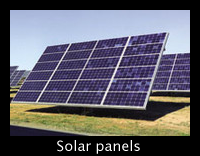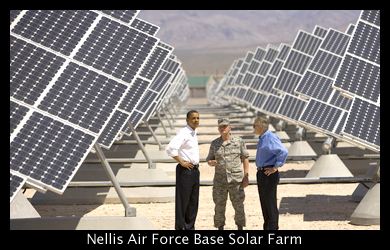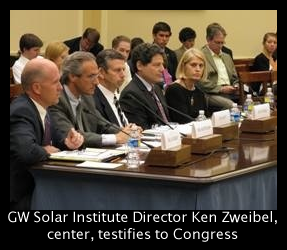
In December 2010, final deliverables for the Solar Institute-funded research project entitled "Determination of Solar Energy Transition Potential of Department of Defense Facilities and Non-Tactical Vehicles," were accepted by Solar Institute Director Ken Zweibel, who called the results "admirable," from the project’s Principal Investigator, E&EM; Professor Jonathan Deason.
Doctoral candidate Ariel Castillo, who served as the principal Research Associate for the project and who undertook the bulk of the investigation work, is using the results in the preparation of his doctoral dissertation on the use of decision aiding technologies in assisting large organizations analyze potential for transition to renewable energy sources, which he is expected to defend in 2011.

The principal focus of Ariel’s research was the development of a decision support model to assist Department of Defense stakeholders in implementing a solar energy infrastructure across 200 sampled Defense installations across the United States. The model resulted from an evaluation of energy, environmental, technical, cost and mission parameters such as fossil energy consumption, CO2 emissions, land availability, solar implementation costs and mission critical infrastructure based on the number of military personnel.

The benefits of implementing solar energy solutions across the Department of Defense includes meeting federal policies and mandates, reducing energy intensity from fossil fuel resources (including foreign oil), reducing carbon dioxide emissions, and improving national security and mission readiness. Implementation of solar energy technologies across Department of Defense bases could assist in the reduction of fossil fuels and carbon dioxide emissions and in the facilitation of Department of Defense compliance with various policies, including the Energy Policy Act of 2005, Executive Order 13423, and Executive Order 13514. Ariel found that the Department of Defense could directly meet fossil fuel and carbon dioxide emission reduction goals set in this major polity instruments by investing in solar energy technologies the importance of Ariel’s work is reflected by the interest of the U.S. Congress in it, as summarized in another article on this issue of the EEM Newsletter.
The benefits of implementing solar energy solutions across the Department of Defense includes meeting federal policies and mandates, reducing energy intensity from fossil fuel resources (including foreign oil), reducing carbon dioxide emissions, and improving national security and mission readiness. Implementation of solar energy technologies across Department of Defense bases could assist in the reduction of fossil fuels and carbon dioxide emissions and in the facilitation of Department of Defense compliance with various policies, including the Energy Policy Act of 2005, Executive Order 13423, and Executive Order 13514. Ariel found that the Department of Defense could directly meet fossil fuel and carbon dioxide emission reduction goals set in this major polity instruments by investing in solar energy technologies the importance of Ariel’s work is reflected by the interest of the U.S. Congress in it, as summarized in another article on this issue of the EEM Newsletter.


